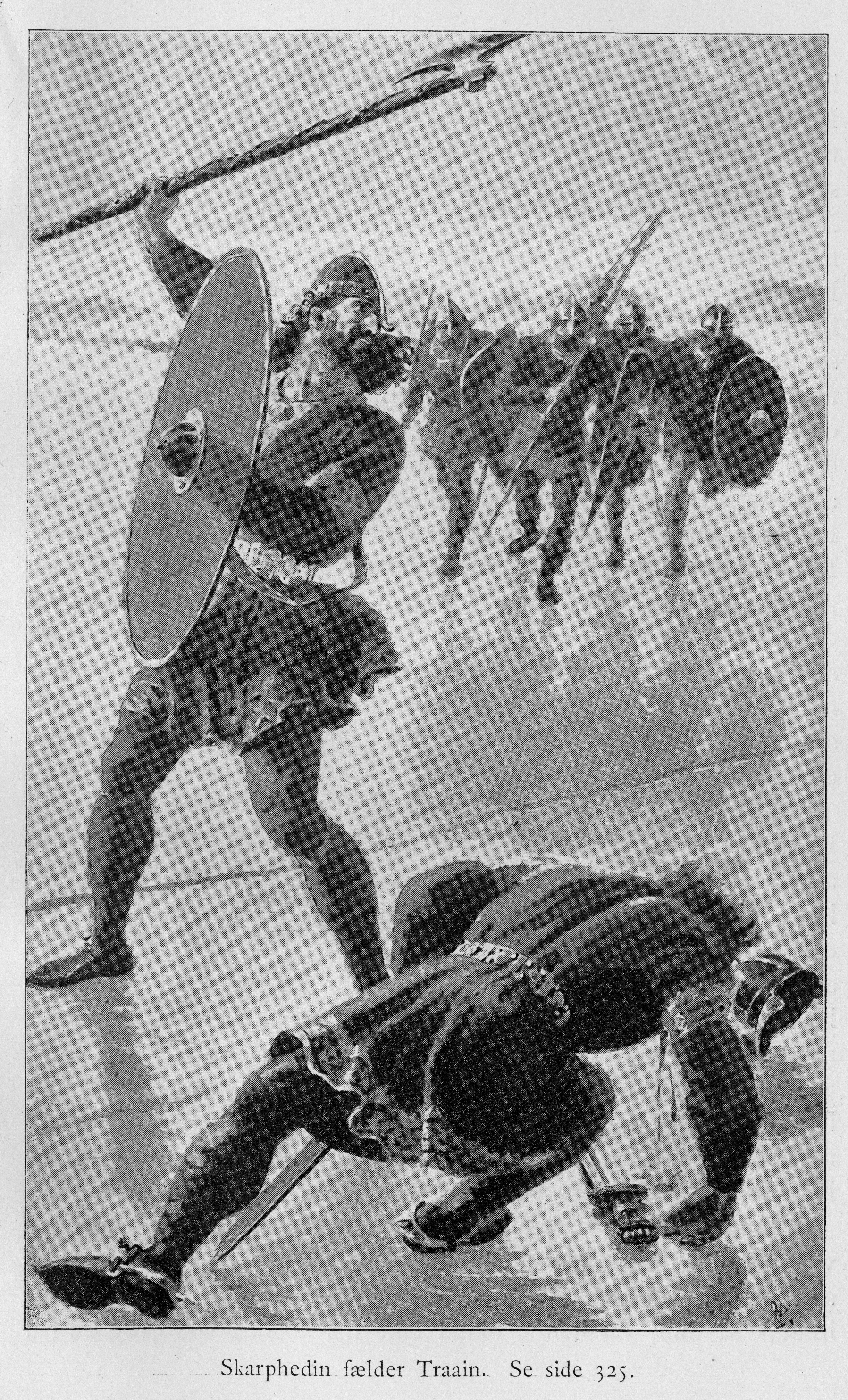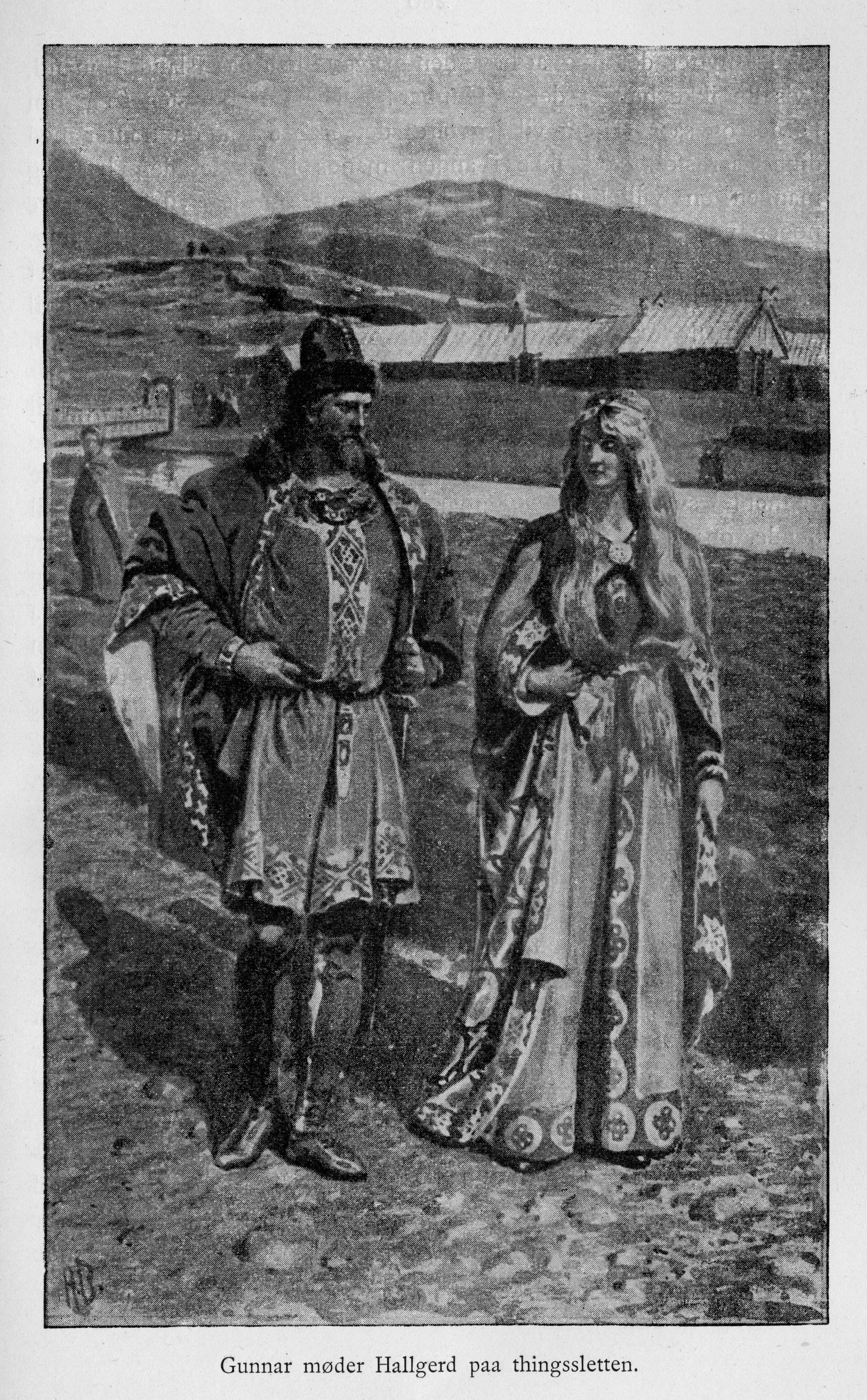|
Skarphéðinn Njálsson
Skarphéðinn Njálsson (Modern Icelandic: ; Old Norse: ) was a semi-legendary Icelander who may have lived in the 10th century. He is known as a character in ''Njáls saga'', a medieval Icelandic saga which describes a process of blood feuds. The saga is now believed to have been composed in Iceland during the period from 1270 to 1290. The eldest son of Njáll Þorgeirsson and Bergþóra Skarphéðinsdóttir, he grew up at Bergþórshvoll in Rangárvallasýsla. The saga describes a series of feuds involving friends of Njáll and later also Njáll and his sons. Skarphéðinn is described as hardy and skilled warrior but also as an ill-tempered and sharp tongued man whose insults of potential allies at the althing ends up isolating the Njáll and his family, leading to their demise as they are burned by their enemies inside their home at Bergþórshvoll. Biography At first the feud is fueled by the anger of Hallgerður Höskuldsdóttir, wife of Njáll's friend Gunnarr, who is ... [...More Info...] [...Related Items...] OR: [Wikipedia] [Google] [Baidu] |
Modern Icelandic
Icelandic (; is, íslenska, link=no ) is a North Germanic language spoken by about 314,000 people, the vast majority of whom live in Iceland, where it is the national language. Due to being a West Scandinavian language, it is most closely related to Faroese, western Norwegian dialects, and the extinct language, Norn. The language is more conservative than most other Germanic languages. While most of them have greatly reduced levels of inflection (particularly noun declension), Icelandic retains a four- case synthetic grammar (comparable to German, though considerably more conservative and synthetic) and is distinguished by a wide assortment of irregular declensions. Icelandic vocabulary is also deeply conservative, with the country's language regulator maintaining an active policy of coining terms based on older Icelandic words rather than directly taking in loanwords from other languages. Since the written language has not changed much, Icelandic speakers can read classic ... [...More Info...] [...Related Items...] OR: [Wikipedia] [Google] [Baidu] |
Old Norse
Old Norse, Old Nordic, or Old Scandinavian, is a stage of development of North Germanic languages, North Germanic dialects before their final divergence into separate Nordic languages. Old Norse was spoken by inhabitants of Scandinavia and their Viking expansion, overseas settlements and chronologically coincides with the Viking Age, the Christianization of Scandinavia and the consolidation of Scandinavian kingdoms from about the 7th to the 15th centuries. The Proto-Norse language developed into Old Norse by the 8th century, and Old Norse began to develop into the modern North Germanic languages in the mid-to-late 14th century, ending the language phase known as Old Norse. These dates, however, are not absolute, since written Old Norse is found well into the 15th century. Old Norse was divided into three dialects: Old West Norse, ''Old West Norse'' or ''Old West Nordic'' (often referred to as ''Old Norse''), Old East Norse, ''Old East Norse'' or ''Old East Nordic'', and ''Ol ... [...More Info...] [...Related Items...] OR: [Wikipedia] [Google] [Baidu] |
Njáls Saga
''Njáls saga'' ( ), also ''Njála'' ( ), ''Brennu-Njáls saga'' ( ) or ''"The Story of Burnt Njáll"'', is a thirteenth-century sagas of Icelanders, Icelandic saga that describes events between 960 and 1020. The saga deals with a process of blood feuds in the Icelandic Commonwealth, showing how the requirements of honor could lead to minor slights spiralling into destructive and prolonged bloodshed. Insults where a character's manhood is called into question are especially prominent and may reflect an author critical of an overly restrictive ideal of masculinity. Another characteristic of the narrative is the presence of omens and prophetic dreams. It is disputed whether this reflects a fatalism, fatalistic outlook on the part of the author. The principal characters in the saga are the friends Njáll Þorgeirsson, a lawyer and a sage, and Gunnar Hámundarson, a formidable warrior. Gunnar's wife, Hallgerðr langbrók, instigates a feud that leads to the death of many character ... [...More Info...] [...Related Items...] OR: [Wikipedia] [Google] [Baidu] |
Njáll Þorgeirsson
Njáll Þorgeirsson (Old Norse: ; Modern Icelandic: ) was a 10th and early-11th-century Icelandic lawyer who lived at Bergþórshvoll in Landeyjar, Iceland. He was one of the main protagonists of ''Njáls saga'', a medieval Icelandic saga which describes a series of blood feuds. Biography Njáll was the son of Þorgeir gollnir Ófeigsson. His paternal grandfather had fallen out of favour with the king and therefore decided to leave Norway but as he had prepared and was about to leave when the king's errandmen came to him and took his life. After that his grandmother and their children and her brother left for Iceland. ''Njáls saga'' does not in important events contradict other sources but in details such as genealogy it sometimes contradicts the ''Landnámabók'' which is thought more trustworthy. The name Njáll is a Norse derivative of the Irish name Niall. Njáll lived in Bergþórshvoll and was married to Bergþóra Skarphéðinsdóttir. He is described as a kindly, wealth ... [...More Info...] [...Related Items...] OR: [Wikipedia] [Google] [Baidu] |
Bergþórshvoll
Bergþórshvoll (Modern Icelandic: ; Old Norse: ; usually anglicized as ''Bergthorsknoll'') is an area in Vestur-Landeyjar in Rangárvallasýsla, Iceland. Bergþórshvoll is an important setting in the Icelandic saga '' Njál's saga'', the home and scene of the final burning of Njáll Þorgeirsson Njáll Þorgeirsson (Old Norse: ; Modern Icelandic: ) was a 10th and early-11th-century Icelandic lawyer who lived at Bergþórshvoll in Landeyjar, Iceland. He was one of the main protagonists of ''Njáls saga'', a medieval Icelandic saga which de ... and his entire family. Antiquarian Sigurður Vigfússon (1828–1892) conducted an archaeological dig on the site at the end of the 19th century. Matthías Þórðarson (1877-1961) made an extensive excavation at Bergþórshvoll during 1927, 1928 and 1931. References External linksIcelandic site Sagas of Icelanders {{Iceland-saga-stub ... [...More Info...] [...Related Items...] OR: [Wikipedia] [Google] [Baidu] |
Rangárvallasýsla
Iceland was historically divided into 23 counties known as ''sýslur'' (), and 23 independent towns known as ''kaupstaðir'' (). Iceland is now split up between 24 sýslumenn (magistrates) that are the highest authority over the local police (except in Reykjavík where there is a special office of police commissioner) and carry out administrative functions such as declaring bankruptcy and marrying people outside of the church. The jurisdictions of these magistrates often follow the lines of the historical counties, but not always. When speaking of these new "administrative" counties, the custom is to associate them with the county seats rather than using the names of the traditional counties, even when they cover the same area. Composition Independent towns (''kaupstaðir'') were first created in the 18th century as urbanisation began in Iceland; this practice continued into the 1980s. The last town that was declared an independent town was Ólafsvík in 1983. Since then, th ... [...More Info...] [...Related Items...] OR: [Wikipedia] [Google] [Baidu] |
Althing
The Alþingi (''general meeting'' in Icelandic, , anglicised as ' or ') is the supreme national parliament of Iceland. It is one of the oldest surviving parliaments in the world. The Althing was founded in 930 at ("thing fields" or "assembly fields"), situated approximately east of what later became the country's capital, Reykjavík. Even after Iceland's union with Norway in 1262, the Althing still held its sessions at until 1800, when it was discontinued. It was restored in 1844 by royal decree and moved to Reykjavík. The restored unicameral legislature first came together in 1845 and after 1874 operated in two chambers with an additional third chamber taking on a greater role as the decades passed until 1991 when Althing became once again unicameral. The present parliament building, the , was built in 1881, made of hewn Icelandic stone. The unicameral parliament has 63 members, and is elected every four years based on party-list proportional representation. The current ... [...More Info...] [...Related Items...] OR: [Wikipedia] [Google] [Baidu] |
Gothi
Gothi or (plural , fem. ; Old Norse: ) was a position of political and social prominence in the Icelandic Commonwealth. The term originally had a religious significance, referring to a pagan leader responsible for a religious structure and communal feasts, but the title is primarily known as a secular political title from medieval Iceland. Etymology The word derives from , meaning "god".Byock, Jesse L. (1993). "Goði". Entry in ''Medieval Scandinavia, an Encyclopedia'' (Phillip Pulsiano, ed.), 230–231. Garland: NY and London, . It possibly appears in Ulfilas' Gothic language translation of the Bible as for "priest", although the corresponding form of this in Icelandic would have been an unattested . In Scandinavia, there is one surviving attestation in the Proto-Norse form from the Norwegian Nordhuglo runestone (Rundata N KJ65 U),The article ''gotiska'' in ''Nationalencyklopedin'' (1992) and in the later Old Norse form from three Danish runestones: DR 190 Helnæs, DR 192 ... [...More Info...] [...Related Items...] OR: [Wikipedia] [Google] [Baidu] |





